Harry Bryan’s Rambler 18 is a handsome lap-strake runabout designed to carry the whole family for a daylong outing —exploring the coast or perhaps visiting friends on an offshore island. Though just 18′ in length, she’s big enough to take everything a couple would need for a week’s camp-cruise. Weighing 900 lbs, it should trailer easily behind the family car and launch without causing undue strain on the engine.
Bryan specifies a 9.9-hp, high-thrust Yamaha outboard motor, which gives better fuel economy than a larger engine. The boat’s hull design trades speed over the water for a gentle ride through the water. While the large-diameter propeller will push Rambler at speeds up to 8 knots, the optimum speed for cruising is about 6 knots—fast enough to reach your destination, but slow enough to enjoy the scenery.
The bow’s narrow entry slices through the water so the boat doesn’t pound—softening the ride through the chop. There are no white knuckles and no hanging on for dear life that one might have experienced in the past with the slapping of a planing hull. The hull’s after sections have no deadrise, providing some lift. The hard chine aft adds stability, both at the dock and at speed. The keel has significant rocker; it rises to the waterline at the transom, reducing the wake and making the hull more fuel-efficient than heavier boats at slightly over hull speed.
Typically an 18-footer, powered by a 90-hp outboard, carving circles in a lake at full throttle, will use up to 8 gallons per hour, burning through roughly $32 in one hour at today’s price of nearly $4 a gallon. The Rambler 18 will carry you to new waters and back, running all day at 6 knots, burning about half a gallon per hour, or just $16 for an eight-hour day.
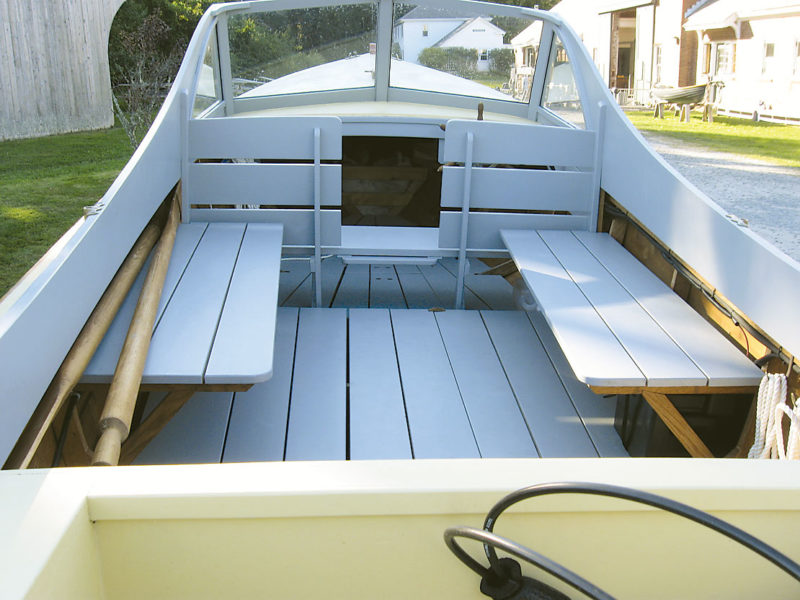 Robin Jettinghoff
Robin JettinghoffA spacious cockpit will seat six and accommodate all their gear for a day on the water.
The Rambler’s hull has a sweet sheerline accentuated by a softly sweeping coaming that curves aft from a raked windshield. Bryan built the boat upside down starting with an oak keel fastened to a stem and forefoot of black locust. The frames are attached to the keel next. No molds are needed as the ½” copper-riveted lapstrake planking can be fastened to the 7 ⁄8″ × 2″ sawn oak frames. All other fastenings are bronze. The hull has a spray rail at the stem just above the waterline to help keep the cockpit dry. This rail extends aft about 6′ to where the chine becomes visible. The hull sections change from a smooth curve at the bow to a near right angle at the transom.
Bryan says this boat could be built using glued-lap plywood. Another option would be to use sheet plywood for the topsides; however, the bottom would have to be built of two layers of laminated plywood strips in order to achieve the correct shape. While underwater the bow’s entry angle is fine to cut through the chop, above the chine it flares outward, to deflect spray. To add comfort for the crew, the windshield has large windows to port and starboard for protection from spray. The cockpit has two spacious seats forward for the driver and a passenger. Benches running fore-and-aft behind these seats will comfortably hold four adults facing each other thwartships. This arrangement allows the crew to walk down the hull centerline, unobstructed by seats, without disrupting the boat’s trim. An accessible cuddy under the foredeck will hold all the gear they’ll need for the day or a weekend. The transom is high, and forward of it is a splash well. Both of these features help prevent the boat from being swamped by a following sea. The motor tilts into the splash well when it’s not in use. The transom’s sweet tumblehome section echoes the equally sweet curve of the sheer.
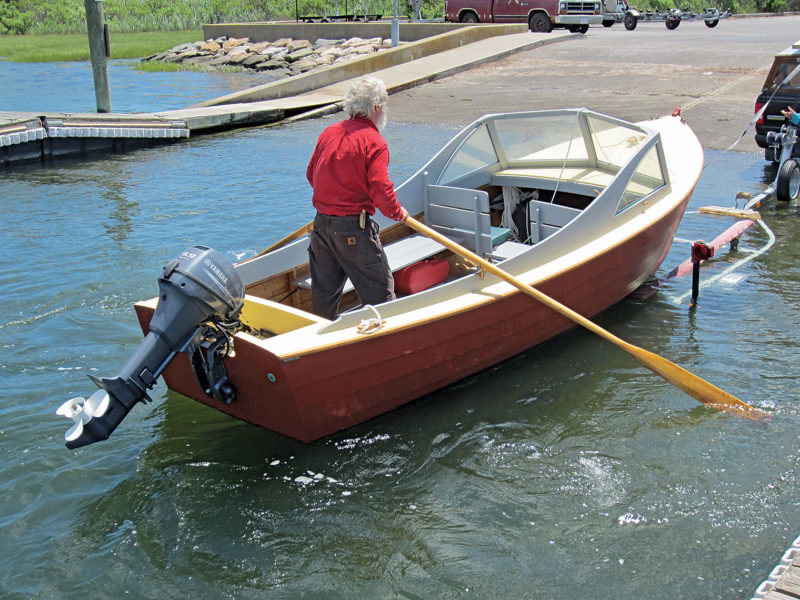 John Marples
John MarplesThe Rambler 18 has a splash well in front of the motor to help prevent the boat from being swamped by a following sea. The motor tilts into the well when not in use.
Like many of Bryan’s boats, the Rambler 18 just invites you to touch her, to rub your hand along her, to climb aboard. As you sit in the driver’s seat and grab the wheel, everything about her is effortless. As you pull away from the dock and throttle up to speed, everyone aboard can anticipate a comfortable ride. Passengers will be able to talk easily to each other over the relatively quiet engine. If your destination is a beach, Rambler’s shallow aft sections allow her stern to be brought right to the water’s edge, once the outboard is kicked up, for unloading of passengers and their picnic and swimming gear.
Bryan has designed three other Ramblers—at 16½’, 20′, and 23′ long. All three of them carry inboards, and the larger models have covered wheelhouses. His Handy Billy, available in 18′ and 21′ lengths, is another outboard launch design that is seaworthy, comfortable, and fuel-efficient. The Handy Billys are built with batten-seam construction and carry their outboards in a well. The Handy Billy was conceived to offer a low-powered alternative to the average 68 hp of North American boats. The Rambler 18 continues this theme, but with the dramatically lower power needs of a displacement hull.
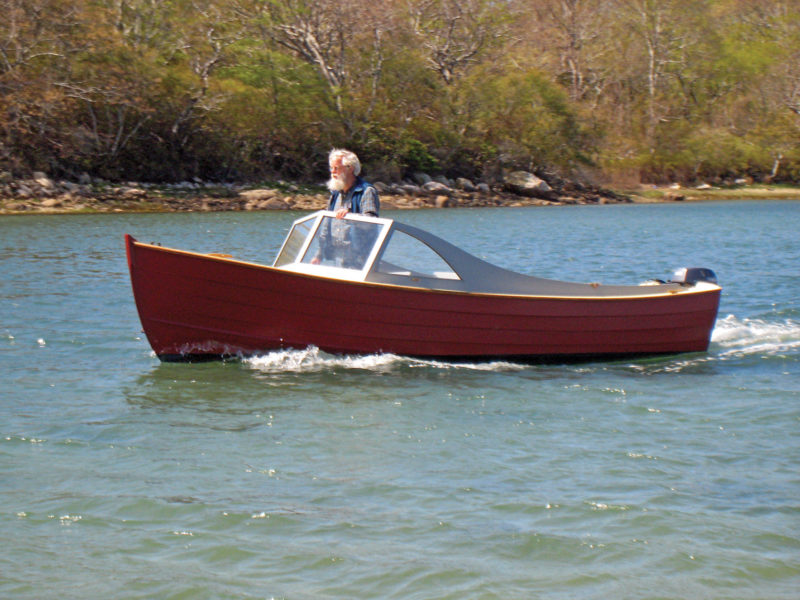 Martha Bryan
Martha BryanBryan chose a 9.9-hp high-thrust outboard motor, which has a larger propeller than a standard motor. It will move the Rambler 18 at 8 knots.
Bryan conducted his sea trials for the Rambler 18 in Buzzards Bay, Massachusetts, in May 2012. He reports that she easily ran against a 4 knot current in the famously swift waters of Woods Hole, and out into the choppy bay beyond. The four adults aboard that day reported a safe, dry, and comfortable ride.
Later in the season, I joined Harry for a ride in the Westport River in Massachusetts. The wind was light but there was a strong current. Rambler was easy to maneuver, turning smoothly in tight circles, accelerating and decelerating without significant changes in trim. Our top speed was about 8.5 knots, but most of the time we easily cruised at an economical 6 knots with two adults aboard. There were five of us aboard for a short run, and her performance did not change noticeably with the added weight.
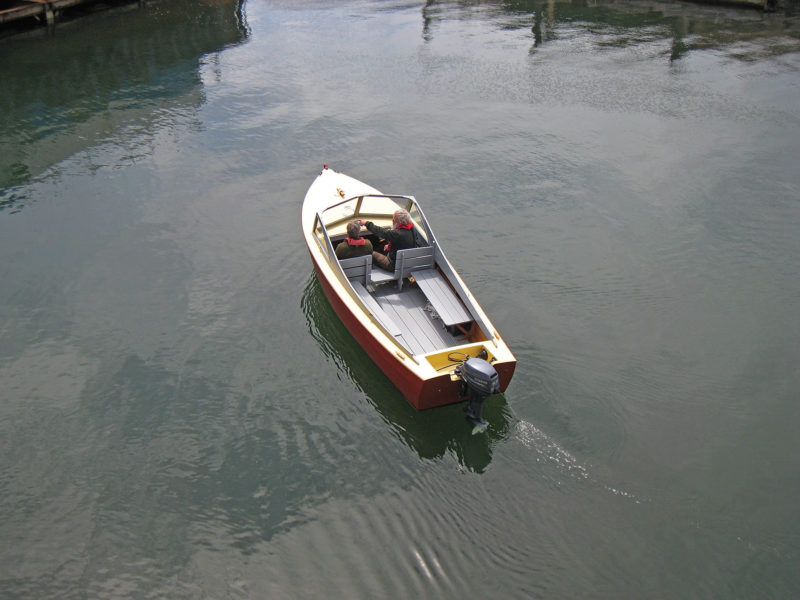 Martha Bryan
Martha BryanRambler’s maple windscreen sweeps aft on both sides of the cockpit, protecting passengers from spray.
Racing around at top speed is not the only way to travel in small powerboats. The Rambler 18 is for people seeking comfortable cruising, not the exhilaration of speed. Riding in this boat is a pleasant and relaxing experience. But the boat is also large enough and powerful enough to handle modest currents and choppy seas while keeping everyone aboard dry.
On his website, Bryan has a quote from boat designer Andre Mele, whose book Polluting for Pleasure caused quite a stir in the recreational powerboat world almost 20 years ago. Mele said the recreational boating industry has been selling adrenaline and glory to the males, and white knuckles to the wives and children, for years. The Rambler 18 is a stable, comfortable, and economical alternative to this mass-market phenomenon. ![]()
Plans and completed boats are available from Harry Bryan, Bryan Boatbuilding, 329 Mascarene Rd., Letete, NB, E5C 2P6, Canada; 506–755–2486; www.harrybryan.com.
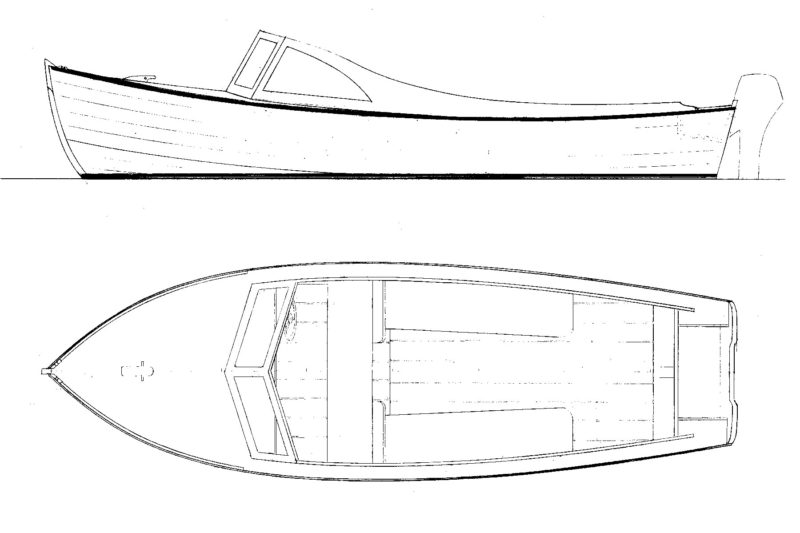
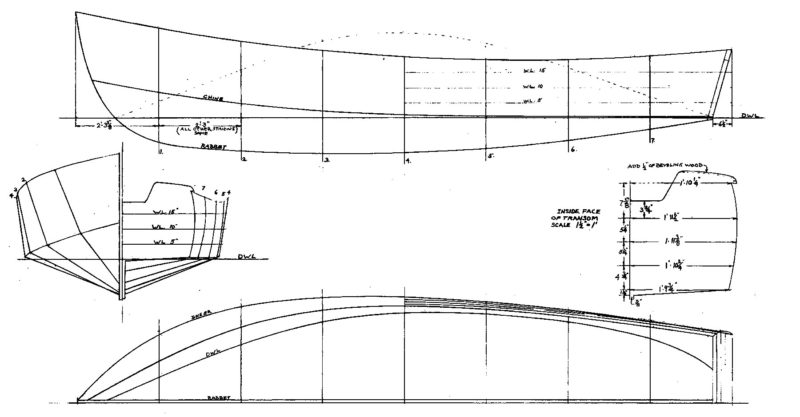
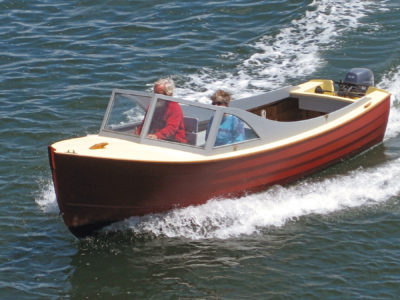
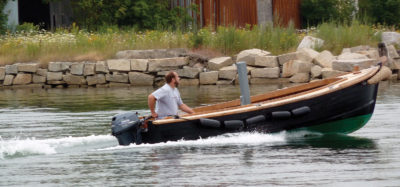


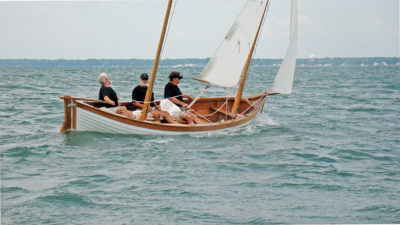
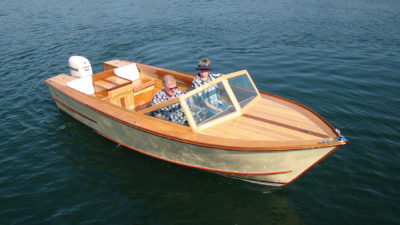
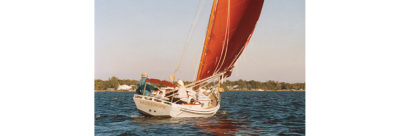
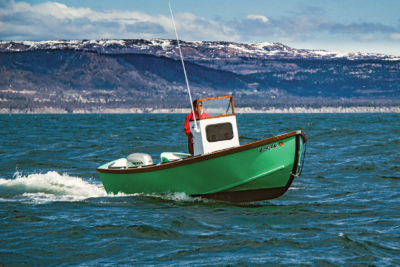
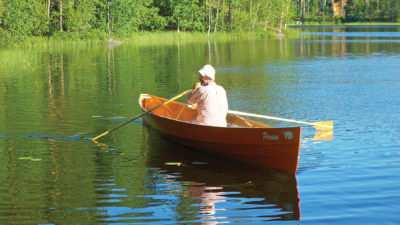
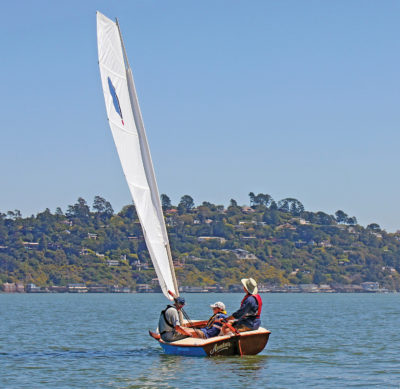
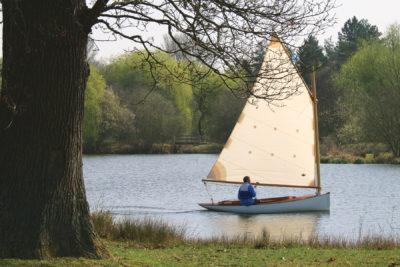
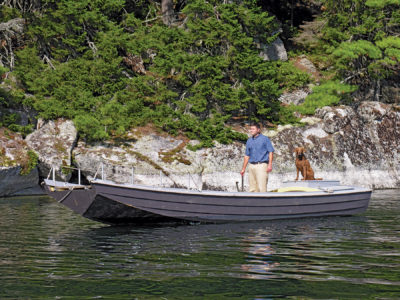
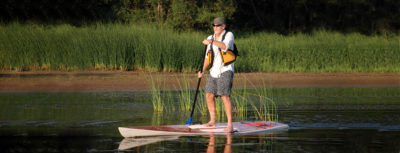
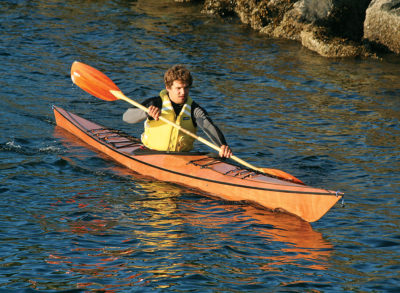

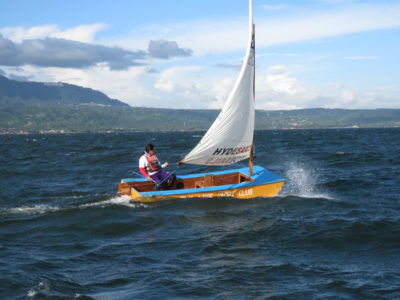
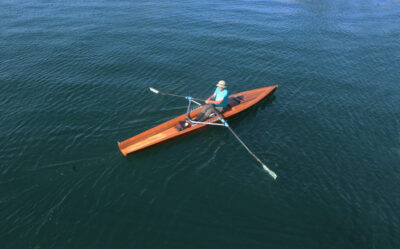
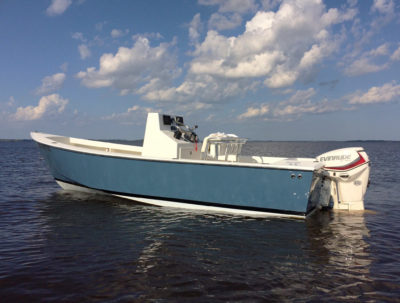
Photos of the Rambler 18 bring back my childhood memories. The Rambler is almost identical to the 19′ cabin cruiser my dad begun building in the early 1950s. The plans were acquired through Motor Boating magazine that he subscribed to at the time. We lived in Fort Lauderdale when the project was started and I recall loading the parts in the moving trailer when we moved back to Ohio in 1956. For the duration of my childhood, our one-car garage was occupied with the project. I have visions of Dad sanding the hull on the weekends. With a borrowed older Mercury outboard, the boat was launched on the Miami River, a tributary to the Ohio River. There were a few more outings that summer but those ended when the old Merc’ died. A new outboard was purchased for the following summer, however, sadly my dad had a stroke one day before the delivery of his new motor. I now live in Seattle and have been a boat owner the past forty years. This summer I downsized to a 10′ wooden pram used for my trout fishing. As long as my shoulders don’t give out the oars (built in Maine by Tenney & Shaw) work very good. I wish Dad was along to see me now!